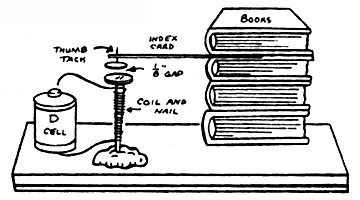Build a Telegraph Tapper
Activity adapted from Scholastic Teachers “Got the Message” and retired Montclair State University Prof. Tom Perera’s online W1TP Telegraph & Scientific Instrument Museum‘s How to Build a Simple Telegraph Sets.
Summary
Students learn the basics of electricity and sound by designing and building a working telegraph system using batteries, wire, and other simple parts. They then use their telegraphs to send and receive messages.
Grade level: 4-8
Time:
Learning Objectives
After doing this activity, students should be able to:
- Understand how telegraphs work
- Understand simple electrical circuits
- Design, build, and troubleshoot a device that transmits signals using electricity
- Send Morse code
Learning Standards
Next Generation Science Standards
-
- Define a simple design problem reflecting a need or a want that includes specified criteria for success and constraints on materials, time, or cost. [Grades 3 – 5]
- Make observations to provide evidence that energy can be transferred from place to place by sound, light, heat, and electric currents. [Grade 4]
- Apply scientific ideas to design, test, and refine a device that converts energy from one form to another. [Grade 4 physical science]
- Modern civilization depends on major technological systems. Engineers continuously modify these technological systems by applying scientific knowledge and engineering design practices to increase benefits while decreasing costs and risks. [H.S.]
- Design, build, and refine a device that works within given constraints to convert one form of energy into another form of energy [H.S.]
International Technology and Engineering Educators Association
- Communication technology is the transfer of messages among people and/or machines over distances through the use of technology. [Grades 3 – 5 ]
Engineering connection
The electric telegraph, developed in the 1830s and 1840s by Samuel Morse and other inventors, is one of the most important inventions in the history of science, technology, and engineering. It directly led to the development of all digital communications, including computers, fax, the Internet, e-mail, and text messaging.
Railroads played a major role in establishing America’s first national telecommunication system. Indeed, as the last spike was driven in the Transcontinental Railroad on May 10, 1869, at Promontory Point, Utah, a telegraph line captured the vibrations so the nation could “hear” the railroad’s completion. The message “Done” also was sent via telegraph, ushering in an era of economic expansion, commerce, and exploration.
Introduction
Today, we take long-distance communication for granted. We just pick up a phone, punch a few buttons, and bingo! – we can speak to someone halfway around the world. While technology like satellite links and microchips have improved the speed and quality of communication, the basic concept of instantaneous long-distance communication lies in Samuel Morse’s telegraph system.
Materials
Per each group of four students:
- 3-inch steel nail
- fist-sized lump of clay
- 20-inch-long piece of thin, insulated wire, with ends stripped bare (available at a hardware store or electronics store such as Radio Shack)
- 5- by 1-inch strip of index card
- steel thumbtack
- 3 or 4 large books or wooden building blocks
- “D” cell battery
- tape
For each student:
Procedure
With the class:
- Start by having the class sit quietly. Tell students that you are going to send them a secret message that they have to decode.
- Using a ruler, make three very fast taps followed by three slow taps and then three very fast taps on the desk. Ask: Who know what the message is. (Some students might recognize the pattern as S.O.S.) Explain to students that SOS was chosen as the universal distress signal in Morse code because this combination of letters creates a distinct and unmistakable sound pattern. Morse code is a way of sending messages over long distances using a device called the telegraph.
In teams:
Divide the class into groups of four. Tell students they will build a simple Telegraph Tapper and then send a message to other members of their group.
Distribute the student worksheets and Morse code conversion chart to each student.
Build the telegraph:
1. Wrap at least 40 turns of wire around the middle of the nail to form the electromagnet. Make sure to leave at least 5 inches of wire on each end of the coil to attach to the “D” cell.
2. Push the thumbtack through the middle of the index card strip, about ¼ inch from one end.
3. Set up your telegraph sounder as shown. Make sure the nail rests directly under the thumbtack. The gap between the two should be about 1/8 inch.
4. Securely tape one end of the wire coiled around the nail to the flat end of the “D” cell. Briefly touch the other end of the wire to the bumpy end of the cell. The electromagnet will attract the thumbtack and make a “click.” Lift the wire and the thumbtack should release. (If the thumbtack stays stuck to the nail, the gap between the two is too small. Adjust the nail in the clay to add more space between the two. If the thumbtack doesn’t stick to the nail, the gap is too wide.)
Questions to Think About
1. Why do you need to have at least 40 turns of wire on the nail to make the sounder work? (You need a strong magnetic field to pull the nail head and thumbtack together.)
2. Could a brass paper fastener replace the steel thumbtack in the sounder? (no) Why? (Brass is not magnetic.)
3. Why do you need to adjust the position of the nail head before sending your messages? (To get the clicking sound, you need to have a significant distance between the nail head and the thumbtack.)
Safety Considerations
Tell students not to touch the “D” cell for more than 10 seconds at a time because they could burn their fingers.
Activity extensions
Long-Distance Tapping
The real test of any communication device is to send messages over a distance! Challenge students to build a system that would work between rooms at a distance of more than 20 feet. (Students may need to use a 6-volt lantern battery instead of the “D” cell.)
Activity scaling
- With older students, have them build simple telegraph systems using the process outlined in the W1TP Telegraph & Scientific Instrument Museum’s How to Build a Simple Telegraph Set. (See below for process).The site includes photos of telegraphs built by students from around the world, many of them taking first place in their science fairs!
- Build Your Own Telegraph Key. DIY lesson on building a telegraph key using a clothespin, wires, and arduino. [YouTube 1:22]
See below for materials and construction procedure.
Additional resources
- Samuel F.B. Morse papers at the Library of Congress. Digitized collection of the telegraph inventor’s drawings, letters, manuscripts, and images.
- Invention of the telegraph. Library of Congress brief history.
- Railway map of the United States, circa 1918. Library of Congress digitized transportation and map collection.
- Texting or Telegraphing, which is faster? 2009 Canadian breakfast TV show’s fun competition between two retired railroad telegraph operators and a texting ace. [YouTube 8:42]
Build a Simple Telegraph Set.
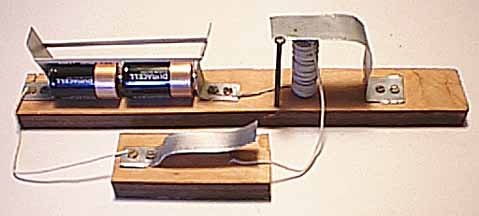
Many people just want to build a very simple set to become familiar with the basic principles of the electric telegraph.
The following project is the simplest functional telegraph system construction project that I could design. It requires very few parts and all of them should be commonly available.
Materials:
- 2 Pieces of wood. (Any kind of wood will do fine.)
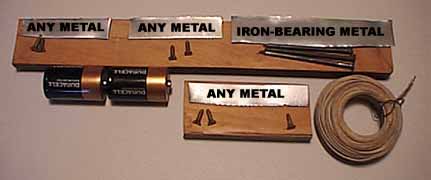 9 Small wood screws or nails.
9 Small wood screws or nails.- 2 Large IRON nails.(About 2-3 inches long.)
(NOTE: It is important that these be IRON or STEEL nails. Aluminum and copper nails will not work.)
(You can test these nails to be sure that they are Iron or Steel by making sure that a magnet is attracted to them or by holding a magnetic compass against them to see if it deflects the compass needle.) - 4 Flat strips of bendable metal.
Three of them should be about 4 inches long.
One should be about 7 inches long.
The long one MUST be iron-bearing or so-called “ferrous” metal which is metal that is attracted by a magnet.
(This kind of metal is often found in some food cans.)
(Be careful not to cut yourself as you cut the strips of metal !)
(You can test this metal strip to be sure that it is ferrous by making sure that a magnet is attracted to it or by holding a magnetic compass against it to see if it deflects the compass needle. - 20 ft or more of INSULATED solid electrical wire.
(22 – 30 gauge…. (the metal part of the wire should be about 1/64 inch or less in diameter.)
(Radio Shack sells appropriate wire as part number: 278-1345, 278-1215, or 278-502 for about $4.00 ) Note: The MORE turns of wire you can wind around the nail, the stronger its magnetism will be and the better it will work.) - 2 Flashlight batteries. (The “D” Cells shown work best.)
CONSTRUCTION:
Construction of the telegraph set is very simple. Just look at the photographs and you will see how it is put together.
BE CAREFUL NOT TO CUT YOURSELF ON THE EDGES OF THE METAL STRIPS.
If children will be using the set, you will want to round all sharp corners with a file or sandpaper and perhaps put tape over any exposed sharp edges.
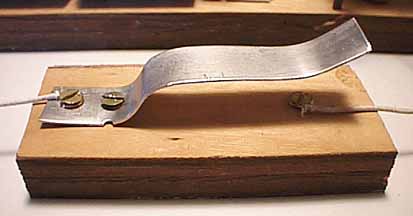 The key is made by screwing one of the strips of metal to one of the pieces of wood so that pushing down on the strip brings the strip into electrical contact with the screw that is mounted under it.
The key is made by screwing one of the strips of metal to one of the pieces of wood so that pushing down on the strip brings the strip into electrical contact with the screw that is mounted under it.
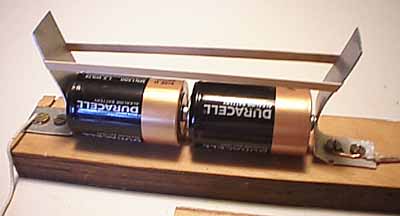 The Battery Holder: is made by screwing two of the metal strips to the wood so that they can make electrical contact with each end of the lineup of the two batteries. A rubber-band may be used to maintain pressure on the battery contacts.
The Battery Holder: is made by screwing two of the metal strips to the wood so that they can make electrical contact with each end of the lineup of the two batteries. A rubber-band may be used to maintain pressure on the battery contacts.
Be sure to put the batteries in the holder with the positive tip of one battery pushing against the negative bottom of the other battery. This is called a “series connection” of the batteries and adds the 1.5 volt voltage of one battery to the 1.5 volt voltage of the other battery to produce a total of 3 volts. Most flashlights are designed this way.
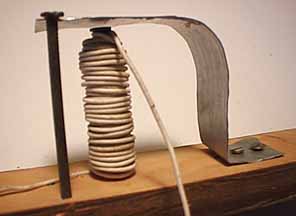 The Sounder: requires a bit of care in construction and adjustment.
The Sounder: requires a bit of care in construction and adjustment.
The electromagnet coil consists of one of the iron nails with at least 100 turns of the wire wound neatly around it. ( If possible wind on 200 or more turns to make the magnetic force stronger. )
The longer iron-bearing strip of metal is screwed to the wooden base and bent so that it extends up and over the top of the nail. This piece has been labeled “IRON-BEARING” in the parts photograph to indicate that it is pulled in by the magnet. Many food cans are made of this type of metal. Be careful not to cut yourself on any sharp edges.
When the electric current passes through the coil of wire, it makes the nail into an electromagnet which pulls the strip of metal down to the nail and makes a clicking sound. (You may have to carefully adjust the strip of metal so it is close enough to the nail allow it to be pulled down by the magnet.)
The second nail is important because it keeps the strip of metal from pulling too far away from the electromagnet. It also serves to make a clicking sound when the strip of metal is released by the magnet and moves upward.
To complete the telegraph set, simply connect the key, batteries, and sounder with the wires as shown in the first picture.
SAFETY NOTE:
When the coil is de-energized by opening the telegraph key, some stored electricity is released.
It is possible to receive an electric shock if you are touching both of the contacts of the key with your fingers while you release the key.
(This can not happen if you build the telegraph key as shown in the pictures because the bottom contact can not be touched while pressing the key down.)
There are two ways to eliminate this problem:
1. Make it impossible to touch the lower contact of the key.
The key in the pictures has a lower contact that is covered by the top contact and it is not possible to touch it at the same time that the top of the key is being pressed.
2. Place a diode between the two contacts on the key. Radio Shack sells a diode that will absorb the electricity when the key is released. The Radio Shack part numbers for appropriate diodes are: 276-1101, 276-1102, 276-1102 or 276-1104 and they cost about $ 1.00.
Just connect the two wires of the diode to the two contacts on the telegraph key with the white band on the diode being connected to the side of the key that is connected to the positive (+) side of the battery. If you have connected the diode incorrectly, opening the key will not open the circuit. In that case, simply reverse the diode connections.
OPERATION OF THE TELEGRAPH SET:
When you push down on the telegraph key it completes the electrical circuit from the key to one end of the coil and from the other end of the coil to one end of the battery and from the other terminal of the battery back to the other side of the key.
Now the sounder magnet should pull down the metal strip and make a CLICKING sound. When you release the key, the metal strip should spring upwards and make a CLACKING sound.
(If it does not work, please see the “Troubleshooting section below.)
You can learn to tell the difference between the dots and the dashes of the Morse code by learning to tell the difference between the pull-in “CLICK” and the release-“CLACK”.
The pull-in “CLICK” is the sound the metal strip makes when it is pulled in by the electromagnet coil and strikes the nail which is in the center of the coil.
The release “CLACK” is the sound that the metal strip makes when it is no longer pulled by the electromagnet coil and it moves rapidly upward to strike the upper nail.
The Morse Code Characters are called DOTS (or ‘dits’) and DASHES (or ‘dahs’) They are made from the CLICKS and CLACKS as follows:
A DOT is created when there is just a LITTLE time between the pull-in CLICK and the release CLACK.
Try it now: Push the key and quickly release it.
Did you hear the CLICK followed quickly by the CLACK ?
That was a DOT in Morse code.
A DASH is created when there is a LONGER time between the pull-in CLICK and the release CLACK.
Try it now: Push the key and after a short wait, release it.
Did you hear the CLICK followed after a short wait by the CLACK ?
That was a DASH in Morse code.
Now let’s send the letter “A”.
In Morse Code, the letter “A” is: DOT DASH. (or Dit Dah).
Push down the key and release it quickly to make a DOT and then push down the key, wait a bit, and release it to make a DASH.
Try it! You have just sent the Morse Code letter “A”.
Now let’s send your name in Morse Code:
Find the letters in your name in this Morse Code table that shows the dot and dash equivalents of letters and numbers in the American Morse Code and the International code:
http://w1tp.com/percode.htm
(The American Morse Code was mostly used by the railroads and the International code was used for wireless and radiotelegraphy and in foreign lands.)
TELEGRAPH SETS BUILT BY OTHER PEOPLE:
 Here is another version of this set:
Here is another version of this set:
It was made by 13 year-old Claire Berry in KwaZulu-Natal, South Africa. It won a high grade in a science project.
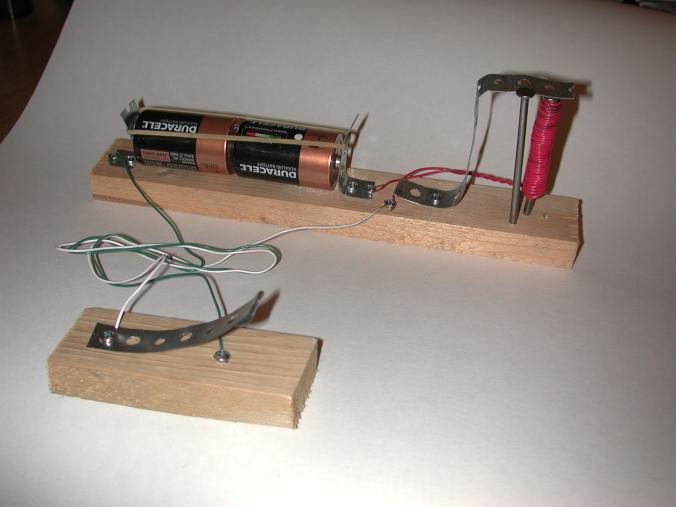 Here is another version of this set:
Here is another version of this set:

An Excellent Modification of my Basic Design by Rahul Sharma:
15 year-old Rahul Sharma in India designed and constructed a system that uses a pencil to write dots and dashes on an electric motor-driven moving paper tape. This makes it easier to read the Morse Coded letters visually and does not require training in listening to a sounder. He recreated the very first method of recording the Morse code message on a paper tape as it was invented and used by Alfred Vail and Samuel Morse. He writes: “I modified your design a little. Instead of a metal strip I made something like a see-saw with ice cream sticks and mounted a metal scale on it. It was much more difficult to make but it gave better results. Also, I installed a register to copy down the code.” Here is a picture of Rahul’s telegraph set: Nice job, Rahul…
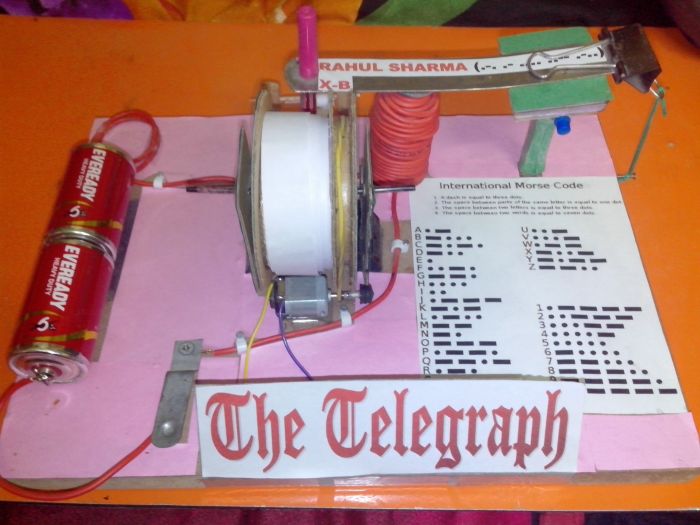
NOTES:
You may use up to 100 feet of wire between the key and the sounder.
Please be careful not to hurt yourself while building this set. The improper use of tools during construction can cause serious injury. The original designer of the set and the maintainer of this web page accept no liability for injuries caused by the construction or operation of the set.
Here is the circuit diagram of the completed telegraph set:
The components are all in what is called a ‘series circuit’. When the key is closed, the electricity flows in ‘series’ from the batteries through the closed key to the sounder and through the sounder coil back to the other terminal on the batteries.
(The 2 batteries are combined
!-----KEY-----!
! !
! BATTERY 1
SOUNDER BATTERY 2
! !
!-------------!
And Here is one of the circuits which will allow two of these sets
to be hooked together to send messages to a distant friend. You may
use up to about 100 feet of wire to connect to the other set:
This is the circuit which was used in the early land-line telegraph
stations. Please NOTE that ONE KEY must be in the 'closed' position
in order for the other key to operate the sounders. Most of the
early keys had a built-in shorting switch to keep the key circuit
closed and make it possible to receive messages. One advantage of
this circuit is that the battery can be at either end of the wire
or even in the middle.
Wires to other set:
!------KEY------X.......BATTERY........X-----KEY-----!
! !
SOUNDER SOUNDER
! SET 1. Set 2. !
!---------------X......................X-------------!
Wires to other set:
*** NOTE: ONE key MUST be kept CLOSED in order for the other to work. ***
Here is another circuit which was designed by Bill Horne, W1AC.
The advantage of this circuit is that it allows either key
to operate the sounders at any time without wearing down the batteries and
without the need to close the circuit closing switches on the keys.
NOTE: For this circuit to work, It IS IMPORTANT to wire the batteries with
the POSITIVE (+) and NEGATIVE (-) Terminals as shown.
If you do not do this, the sounders will close as soon
as they are connected.
NOTE: It is also IMPORTANT to use the same voltage..
( ..for example, 2 D-cell batteries.. ) for each battery.
Wires to other set:
!----SOUNDER----!......................!----SOUNDER----!
+ ! + ! ! + ! +
BATTERY KEY KEY BATTERY
- ! - SET 1. ! ! Set 2. - ! -
!---------------!......................!---------------!
Wires to other set:
*** BE SURE THE (+) and (-) BATTERY TERMINALS ARE WIRED AS SHOWN ***
TROUBLESHOOTING PROBLEMS AND SOLUTIONS
Overheating and dead batteries (CAUSED BY USING UNINSULATED WIRES)
One parent emailed that all his completed set did was to have the coil of wire get very hot and that the batteries went dead shortly afterwards.
After asking him a few questions, I found out that he had wound bare (uninsulated) wire around the nail. I explained that the coil of wire had to be made from insulated wire so that the individual turns in the coil did not electrically connect to each other.
Sticking Sounder Won’t release quickly or at all
One parent noted that closing the key caused the electromagnet to attract the metal armature of the sounder but that it did not release after the circuit was opened.
I suggested increasing the strength of the springiness of the metal that pulled the armature away from the nail…
….. AND
INSERTING a very thin piece of plastic sheeting or wrapping material between the nail and the armature to prevent the metal armature from directly coming into contact with the nail.
Can’t tell the difference between a CLICK and a CLACK
Try using a different metal nail as the upper ‘stop’.
Try putting a bit of aluminum foil on the upper stop to change the sound of the release CLACK.
MODIFICATIONS AND ADDITIONS:
There are many ways that you can modify this basic circuit.
For instance, you could put a flashlight bulb or a 3-volt sounder or buzzer in the series circuit so it would flash or buzz in addition to clicking when you close the key.
This might help some people to learn to copy the Morse Code more easily.
You could also mount a pencil on the sounder arm and have it mark a piece of paper with either a high mark or a low mark while the paper was pulled under the pencil at an approximately constant speed. This would work exactly like Samuel Morse’s very first telegraph systems that were used before people learned to copy the Morse Code by ear. Morse invented what he called a “register” which used a clockwork mechanism to pull a paper tape under a pencil which was moved in and out by an electromagnet.
If you use this system it is quite easy to translate the short or long downwards pencil marks on the paper into dots and dashes. Registers were used to make Morse Code marks on paper tape right up to the time of the American Civil war when people finally discovered they could copy Morse Code by ear. President Abraham Lincoln had a telegraph office that kept him informed of the progress of the Civil War by receiving telegraph messages from his generals in the fields of battle.
Good Luck with your projects…
HOW THE TELEGRAPH WORKS:
Explanation of how the telegraph works:
BUILDING A WORKING ‘WIRELESS’ TELEGRAPH SET:
Please click on the following link if you would like to build: A simple working wireless telegraph set:(15KB)
Filed under: Class Activities, Grades 6-8, Grades 9-12, Lesson Plans
Tags: Class Activities, electricity, Energy, Golden spike transcontinental railroad, History, Lesson Plan, Morse code, sound, telecommunications, telegraph, train









